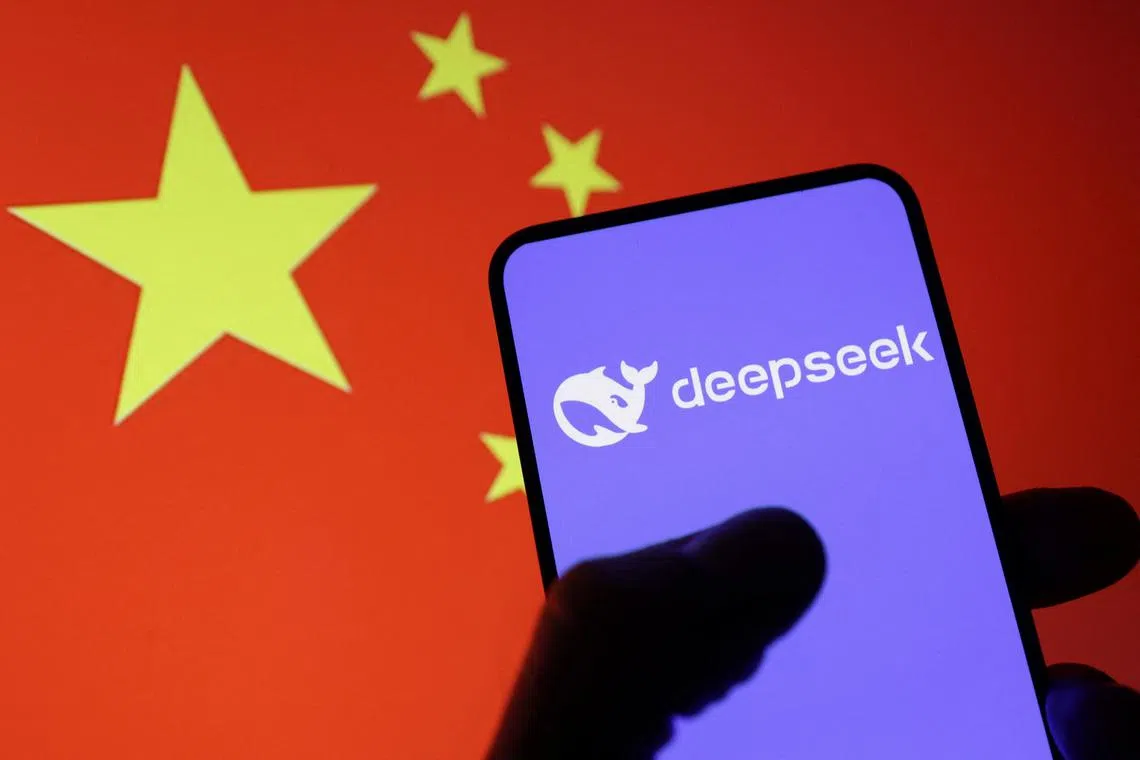Sleepless in Silicon Valley: A cheeky Chinese upstart sparks a ‘deep seek’ in America’s AI industry
Sign up now: Get ST's newsletters delivered to your inbox

DeepSeek may have disadvantaged China when its app topped the most-downloaded charts and triggered a massive sell-off in US stock markets this week.
PHOTO: REUTERS
Follow topic:
WASHINGTON - It’s a story that Silicon Valley ought to love, really: A plucky technopreneur with far fewer resources produces a superior product that is an overnight success.
Yet, a chatbot from China
It has shaken the assumptions of America’s unassailable supremacy in artificial intelligence (AI), threatened the trillion-dollar status of its AI giants, and sounded the gong for a global AI dominance battle.
At first there was excitement about the new toy in town. DeepSeek’s R1, freshly minted in China, was as good as American ChatGPT’s top model o1, said the enthusiasts.
“A lot of my friends view this as exciting, not shocking,” said Dr Andrew Ng, a top British-American AI expert, partly schooled in Singapore’s Raffles Institution in the 1990s.
“It is part of a number of tech trends that have been germinating for a long time that were actually in plain sight but not in public awareness,” said Dr Ng, who co-founded Coursera and has led both Baidu’s AI Group and Google Brain.
“China has been releasing open source models for quite some time. My team has been using Alibaba’s Qwen AI for a number of our applications already,” he said.
A Silicon Valley venture capital manager, speaking off the record, recalled wistfully how his firm’s China arm had encountered the DeepSeek team in its founding days in 2023.
“They told us: We don’t plan to make money from this. It’s going to be a research project, the most cutting-edge foundation model using Chinese native talent. They were not actively seeking funding, they were confident in what they could do.”
It seemed that the Valley was split into two camps after DeepSeek landed.
One side holds that what’s playing out is healthy even if disruptive. It’s how tech and innovation have always evolved.
In China, the AI engineers focused on optimising “compute” or the computational power required to train, fine-tune, and run machine-learning and deep-learning models to cope with a scarcity of high-performance chips owing to US export regulations.
In the US, companies were comfortable wasting hardware to save time while their engineers prioritised speeding their products to market.
That is how it was in the early cloud computing era, where companies focused on market share over efficiency.
The other side is pressing the panic button. Implications have hit home that R1 was likely made on not-so-advanced chips and for less than US$6 million (S$8.1 million).
Some American companies spend billions to train their AI. That’s billions, with a “b”.
Not just that, DeepSeek strategically made R1 open source, that is, software whose source code can be seen, studied and modified by anyone for their own use. It released white papers to detail the recipe it used to bake its model.
Allegations soon surfaced that DeepSeek might have stolen
But the fear sank deeper than for one company. Many experts said China was closing in, that America was losing its edge
So, how far ahead is the US now?
“Right now, I think we are neck and neck,” Mr David Lin, senior director for future technology platforms at the Special Competitive Studies Project, a US-based non-partisan think-tank founded in October 2021 by former Google CEO Eric Schmidt with a mission to preserve America’s AI edge.
“If you asked me three months ago, I would have said that we’re comfortably ahead; it’s very dynamic,” he said.
When Americans think about DeepSeek, the BYD parallel swims into view. This low-cost Chinese maker of electric vehicles planted its flag across the globe in less than a decade, beating rivals on production, sales, key technology, and affordability.
Nor is it BYD alone. Look around and there’s clear evidence of China’s success in owning the market for high-speed rails or drones. Or solar panels. Or batteries. Or steel.
Will that story play out in AI too? An industry zealously guarded by the White House was caught off-guard.
Dr Ng, who has seen both sides of the US-China divide, said DeepSeek had shown that the battle was at a turning point.
“R1 is making more people in the US realise that if the US doesn’t focus on open source development, China could control the AI supply chain,” he said.
Mr Lin said DeepSeek might have overplayed its hand, and may have disadvantaged China when its app topped the most-downloaded charts and triggered a massive sell-off in US stock markets
The hardest hit was leading AI chipmaker Nvidia, listed on Nasdaq, because it appeared that its hard-sought hardware was not so critical to the industry’s success after all.
“Surely DeepSeek’s enjoying their time in the limelight but I would assume that this is getting beyond what they probably originally intended,” said Mr Lin.
“I don’t think that the small, scrappy Chinese AI start-up intended to shake investor confidence in Nvidia in the way it has.
“I’m also very interested in seeing what this means for future open source Chinese releases,” he added.
“Whether or not Beijing may pull the reins to be more controlled in the way Chinese firms come out with these models, to make sure that this lines up with the way Beijing wants to talk about US-China tech competition,” he said.
“When they’re still trying to see how the Trump administration is going to approach tech competition with China, this starts to be a little pokey at the US, which may be a little off-message for what China intends at this stage,” Mr Lin said.
Criticism is raining thick and fast on Silicon Valley
Many US application layer companies were lazy and unoriginal, said Mr David Yin, a Singaporean and long-time Silicon Valley resident who is a partner at GSR Ventures.
His firm specialises in early-stage fintech, blockchain, consumer technologies with a portfolio of investments in China and South-east Asia.
The norm widely prevalent in the Valley was incremental AI applications fuelled by excessive capital, he said in a reference to the billions of dollars that the AI majors have at their disposal.
“When you have people wanting to give you hundreds of billions of dollars, then all you think about is I’m going to add more people, more compute, build my own nuclear power plant,” he said.
“Maybe the Chinese players were not as good as going from zero to one,” he added.
“But once they figured out how to do something, they’re really good at just optimising the crap out of it, and getting from like one to 10 or one to 100.”
It is kind of unfair that the pioneers have had to hire sizeable teams and spend lots of money on building the infrastructure, said Mr Richard Chan, a veteran AI expert.
“Chinese companies have benefited from observing US AI development and can avoid their mistakes. The exchange of ideas and engineers between the US and China also contributes to their advancement. The US restrictions on AI chips forced Chinese companies to be more resourceful,” said the Singaporean who has worked in both the US and China.
“The engineering culture in China is different, there is definitely a lot more work-life balance in the US,” he added.
DeepSeek was knocked for its Chinese origins on some online forums.
“DeepSeek is an outsider, there is fear mongering. A lot of folks are saying – hey, the CCP is going to take that data,” said Mr Yin, referring to the Communist Party of China.
One user called it “vapourware”, saying its weakness was a lack of good data it could access and that there was a delicious irony in open source software from a closed-off nation.
China’s laws forbid its AI models from generating content that “damages the unity of the country and social harmony”. Western AI models censor certain content like self-harm and pornography.
But, how many users want to talk about Taiwan and Tiananmen, countered another.
For Dr Paul Hutchison, an AI expert in the banking and fintech field, the issue boils down to trust.
“The majority of the regulated banking sector is still trying to navigate the traceability and accuracy of responses, as well as risk management, when it comes to using generative AI. It’s not a question of one AI being superior to another,” he said.
“Trust is a major issue if you can’t guarantee the answer’s traceability and stand behind it. It won’t be the tech people pushing back, but risk managers and compliance, asking if the platform can be trusted.”
That being the case, AI is being used more for repetitive tasks than for decision-making, he said. “The ideal solution may be a narrower, specialised AI that can access LLMs (large language models) for interaction, but only consumes data that the user explicitly controls.”
Dr Ng said a battle of values was also playing out.
“It turns out software often embodies a country’s values more than is obvious. Apple’s privacy features, for instance, reflect American values,” said Dr Ng.
“To the extent that models come out of China rather than the US, it means that more and more people around the world will be using models that reflect values from China. That is going to be an important force that governments around the world should consider,” he said.
“Open source AI is important for soft power. America used to understand soft power much better, it seems to have forgotten a lot of those lessons.”
Attention has turned to what President Donald Trump would do – further restrict the export of advanced chips and equipment from the US, which was already curtailed by his predecessor?
“I don’t know if anyone can accurately forecast what our president will do,” said Dr Ng.
“When competing in a race, there are two philosophies. One is to try to run harder and faster. The other is to try to trip up the other guy. I think the US should focus more on running faster and harder,” he said.
Mr Yin said the existing TikTok legislation could be used to ban other Chinese mobile apps, like DeepSeek, on grounds of data security and privacy concerns. DeepSeek’s user agreement explicitly states that data will be stored in China, raising security concerns.
“They’re being very overt about this. And we need to ask ourselves how high a security concern that is, and how do we create the legislative vehicles to protect ourselves against that.”
But in the meantime, AI on the cheap is creating an explosion of opportunities.
Two days after R1, Alibaba dropped its latest Qwen model on the first day of Chinese New Year on Jan 29.
And the week that began with the DeepSeek splash ended with OpenAI releasing o3-mini, its first free reasoning model, available to ChatGPT users.
Thank you, DeepSeek, said one user in reply to OpenAI co-founder and CEO Sam Altman’s post on X, where he had announced the release.
How many days now to R2?
Correction note: The story has been edited to correct the spelling of Alibaba’s AI model Qwen.


